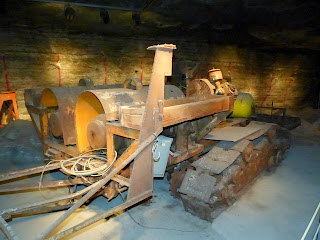Before you ask, it's #4 on the list of 8 Wonders of Kansas. And just in case you think I'm not serious about the list, I have proof. Check out the sign on the side of the building.

I had no idea there were underground salt mines in Kansas. I would have guessed Death Valley or Utah, but Hutchinson, Kansas? The salt deposit extends across (well, I guess "across" isn't the right word for something underground--how about "below"?) 27,000 square MILES of Kansas. They're still mining nearby, but the museum is in the historical section that was mined last century. Old Engine #2 was built by GE in 1919 (one of only three ever built) was used by Carey Salt Company until 1963.
As we should have expected, there was a group of kids on a field trip (different tour, hooray!) Not much to do in the waiting area while waiting for the tour, so I watched some of the boys at the salt lick. (Lick the finger, touch the rock, repeat. Yuck!) There's an assortment of different chunks of salt rocks, intended for looking and touching, definitely not meant for sampling.
There's a safety video, then everyone dons a hard-hat and gets squashed into an elevator for the 650' descent to the mine. The guide asked if anyone needed the lights on, and since no one objected, we rode down in the dark, like the miners do. Takes 90 seconds, and it's kinda weird, and very black, but not claustrophobic or scary. I was trying so hard not to bump into someone around me, I didn't think about it. (Sorry, no picture. Use your imagination. Black is black.)As we should have expected, there was a group of kids on a field trip (different tour, hooray!) Not much to do in the waiting area while waiting for the tour, so I watched some of the boys at the salt lick. (Lick the finger, touch the rock, repeat. Yuck!) There's an assortment of different chunks of salt rocks, intended for looking and touching, definitely not meant for sampling.
Once down, you're in part of the old mine in a section they call the Permian Room, named after the sea that left all this salt behind when it evaporated. The guides point out the layers of salt in the walls, tell you a bit about how the salt was formed, then let you wander down the giant hallway at your own pace. The salt is the light layers, the dark stuff is very old dried up mud.
There's a whole salt mining gallery, explaining the history of the Carey Salt Company. Mike Rowe, the host of Discovery Channel's show, Dirty Jobs, did a segment on the mine. This is definitely another job that would have been on the list of jobs I'd never want to do, but it was interesting.
Apparently it's not cost efficient to haul trash back up, so they just stockpile it there. They even have displays of trash. (What goes in the mine, stays in the mine-they don't haul anything except salt and people back up.)
There's another section about secure storage. Underground Vault and Storage uses part of the mines for storing documents and movie film and memorabilia. (Really? Who'd expect to see Batman's costume in a mine? I guess they send a lot of stuff to the salt mine.)
The Salt Mine Express is a 15-minute train ride that goes through a section of the mine active in the 1940s and 50s. The train is cute (it's a hand-me-down from the Hutchinson Zoo). Obviously it was intended for children, so George wasn't very comfortable in it. It was okay for me...
Occasionally one of those skinny layers of salt and mud break off from the ceiling. This was in a side tunnel. The miners keep a close eye on the ceiling to catch any separations before they fall and do real damage.
The Dark Ride is ride on a tram (little bigger--George was happy) through the tunnels, looking at things left behind, learning more about salt mining. It's dark except when the motion sensor lights turn on as we get near.
This old car was used to move supplies within a section of the mine after it was converted to electricity. No, it's wasn't like today's electric cars that are plugged in to charge the battery--it was plugged in to an extension cord. They could only drive it as far as the length of the extension cord! Poor ugly little thing.
Near the end of the tour, we stopped next to a couple piles of salt. We got to choose a piece smaller than the palm of our hands as a souvenir. George got a bigger piece 'cause his hand's bigger.
So if you go to Strataca, here's a bit of advice: (1) don't expect good pictures and (2) don't lick the walls.
More pics: Strataca


.JPG)




.JPG)



.JPG)


Post a comment.
Post a Comment
Please leave comments here: